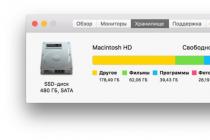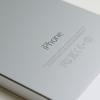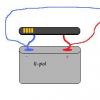Description: MINISTRY OF EDUCATION AND SCIENCE OF RUSSIA Federal State Autonomous Educational "South Federal University" Institute of High Technologies and Piezotechnics Department of Information and Measurement Technologies Sizyakin Stanislav Leonidovich Development of an algorithm for the study of errors MEMS accelerometer
FINAL QUALIFICATION Scientific adviser - Rostov-on-Don - 2016 ANNOTATION. 3 ESSAY. 4 INTRODUCTION 5-6 CHAPTER 1. THEORETICAL PART. 7-28 1.1. Formalization of tasks in the study of MEMS accelerometer errors 7-16 1.2. Characteristics of MEMS accelerometer errors and their classification. 17-21 1.3. Analysis of methods for studying the errors of MEMS sensors. 22-25 1.4. Experimental setup. 25-26 CHAPTER 2. PRACTICAL PART. 29-44 2.1. Static test mode for accelerometers. 29-31 2.2. Development of algorithmic support. 32-37 2.3. Development of a software algorithm. 37-39 CONCLUSION. 40 REFERENCES.. 47 APPENDIX A.. 42 APPENDIX B.. 43-46 ANNOTATION The diploma work contains 47 pages of typewritten text, 17 drawings, 4 tables. This work is devoted to the development of algorithmic and software for the study of statistical errors of a MEMS accelerometer. Within the framework of the task, a static method for studying the errors of the LSM303DLH MEMS accelerometer was considered. The statistical errors of this sensor were also investigated. To solve the problem, algorithmic and software for working with statistical errors were implemented. ESSAY In the thesis, a study of the statistical errors of MEMS accelerometers was carried out, algorithmic and software was developed for studying the errors of accelerometers of the LSM303DLH type. The work consists of two chapters. The first chapter presents general theoretical information, an analysis of methods for studying sensor errors, as well as an analysis of the characteristics of statistical errors of MEMS accelerometers. The second chapter presents the results of the synthesis of algorithmic and software for modeling and studying the statistical errors of LSM303DLH MEMS accelerometers. The experimental setup is described, the research results are presented - the obtained values of the standard deviation, mathematical expectation, covariance, correlation, testing the hypothesis of the normality of accelerometer noise by the Pearson criterion. INTRODUCTION At the present stage of active improvement of microelectronics, the development of microelectromechanical systems, which are more briefly called MEMS, has become widespread. The English equivalent of this term is "Micro ElectroMechanical Systems" (MEMS). MEMS (microelectromechanical systems) are technologies and devices that combine microelectronic and micromechanical components. MEMS devices are usually fabricated on a silicon substrate using micromachining technology, similar to the technology for manufacturing single-chip integrated circuits. Typical sizes of -micro-mechanical elements range from 1 micrometer to 100 micrometers, while MEMS chip sizes range from 20 micrometers to one millimeter. The purpose of this work is to develop algorithmic and software for studying the statistical errors of the LSM303DLH accelerometer. The main purpose of the accelerometer is to provide information about the current acceleration of the device, or rather the difference between the acceleration of the device and the acceleration of free fall. At rest, the sensor readings coincide with the gravitational acceleration vector. Under weightless conditions, the true acceleration of an object is caused only by the gravitational force and therefore is exactly equal to the gravitational acceleration. Thus, there is no apparent acceleration and the readings of any accelerometer are zero Accelerometers belong to the class of inertial sensors, the scope of which is very wide: from mobile phones and tablet computers (one of the tasks is to ensure display rotation) to small-sized strapdown inertial navigation systems integrated with satellite navigation systems, which provide the determination of orientation parameters and coordinates of mobile aircraft, ground , surface and underwater objects. The subject of the study is the study of the statistical errors of the MEMS sensor (micromechanical accelerometer LSM303DLH). In the course of the work, an algorithmic development of the study of such parameters as the standard deviation, mathematical expectation, covariance, correlation, testing the hypothesis for the normality of the distribution of the general population according to the Pearson goodness-of-fit criterion is presented. Software was created in the Delfi 7.0 software environment to calculate these parameters and display graphs of accelerometer readings, mathematical expectation along the x-axis, y-axis, z-axis, frequency histograms for sampling the observed values when testing the hypothesis for the normality of the distribution of the general population according to the Pearson fit criterion. CHAPTER 1. THEORETICAL PART 1.1
Formalization of tasks in the study of MEMS accelerometer errors The object of study is a microelectromechanical (MEMS) three-axis accelerometer LSM303DLH in combination with a three-axis magnetic field sensor. The purpose of the work is to study the errors of this accelerometer, the creation of algorithmic and software for determining the statistical errors of the sensor. The subject of the study is the methods and algorithms for determining the errors of the MEMS accelerometer LSM303DLH Figure 1 - Three-axis accelerometer LSM303DLH The principle of operation of motion sensors (accelerometers and gyroscopes) is based on measuring the displacement of the inertial mass relative to the body and converting it into a proportional electrical signal. The capacitive method for converting the measured displacement is the most accurate and reliable, so capacitive accelerometers are widely used. The structure of a capacitive accelerometer consists of various plates, some of which are stationary, while others move freely inside the case. Capacitances are included in the circuit of the resonant generator. Under the action of the applied control electrical signals, the suspended mass oscillates. A capacitor is formed between the plates, the value of the capacitance of which depends on the distance between them. Under the influence of the acceleration force, the capacitance of the capacitor changes. Figure 2 shows the topology of a MEMS sensor Figure 2 - Topology of the MEMS accelerometer The main structural unit of microelectromechanical accelerometers is a sensing element, the schematic diagrams of which are shown in Figure 2. The sensing element (SE) includes an inertial mass (IM) - 1, elastic suspension elements - 2, a support frame - 3 Figure 3 - types of SE accelerometers Schematic diagram of a MEMS accelerometer 1 - IM, 2 - fixed electrodes, 3 - anchor, 4 - movable electrodes, 5 - frame, 6 - elastic suspension element, 7 - base (body) The inertial mass (IM) is mounted at some distance from the base (case) using two pairs of elastic elements, suspension and anchors. The MI moves in accordance with the measured acceleration α. The capacitive displacement meter is formed by comb structures of electrodes, of which the movable electrodes form a single structure with the MI, and the fixed ones, united by a frame, are fastened by a base (case). The main causes of measurement error in a MEMS accelerometer are temperature, vibration, and cross acceleration. A change in the ambient temperature leads to a change in the value of the dielectric constant ε, the gap between the pendulum plate and the covers. Under the action of cross acceleration, there is an additional deformation of the elastic elements of the suspension and the corresponding movement of the pendulum. The movements of the pendulum along the y axis coincide with the direction of the sensitivity axis and are compensated by the torque sensor, i.e. errors are not introduced. Movements of the pendulum along the z-axis relative to the stationary electrodes of the displacement sensor change the effective area of electrode overlap and, without taking constructive measures, can lead to an accidental error. The possibility of this error is prevented by increasing the area of the electrodes on the caps. The most important accelerometer parameters are the range of measured accelerations, sensitivity, usually expressed as the ratio of the signal in volts to acceleration, non-linearity as a percentage of full scale, noise, temperature drifts of zero (offset) and sensitivity. Thanks to these qualities, they have found their application in many industries: military and civil aviation; automotive industry; aerospace instrumentation; robotics; military industry; oil and gas industry; sport; the medicine. In some cases, an essential characteristic is the natural frequency of the sensor oscillations or the resonant frequency, which determines the operating frequency band of the sensor. In most applications, the temperature range and maximum permissible overloads are important - characteristics related to the operating conditions of the sensors. The defining parameters that affect the accuracy of determining acceleration are drifts of zero and sensitivity (mainly temperature), as well as sensor noise, which limits the resolution threshold of the device. The sensitivity of the sensor depends on the resonant frequency of the mechanical subsystem, as well as the quality of the electronic transducer. The change in sensitivity with temperature is mainly due to the change in the elasticity coefficient. The temperature drift of zero is due to a change in the coefficient of elasticity, thermal expansion, and technological errors in the manufacture of the sensor. The change in the parameters of the electronic part of the sensor under the influence of temperature, as a rule, is significantly less. Because an accelerometer measures acceleration or the force causing an acceleration of an inertial mass, the physical model of an accelerometer is an inertial mass suspended from a spring fixed in a fixed housing - a simple system with one degree of freedom x in the direction of the measuring axis. The inertial mass acquires acceleration under the action of an accelerating force (the resultant inertia force under the influence of acceleration) proportional to the mass m and acceleration a. Power spectral density (noise density, µ g/√Hz rms) in physics and signal processing is a function that describes the distribution of signal power depending on frequency, that is, the power per unit frequency interval. Often the term is used to describe the spectral power of electromagnetic radiation flows or other fluctuations in a continuous medium, for example, acoustic. In this case, it means power per unit frequency per unit area, for example: W/Hz/m 2 . The main characteristics of the LSM303DLH accelerometer are shown in Table 1: Table 1 - Main characteristics of the LSM303DLH accelerometer Figure 5 - Block diagram of the accelerometer LSM303DLH Figure 6 - The location of the pins of the accelerometer LSM303DLH
institution of higher education
WORK OF THE BACHELOR
in the direction 200100 - Instrumentation
Dr. tech. Sciences, Assoc., Igor Shcherban
Table 2 - Assignment of pins of the accelerometer LSM303DLH
Figure 7 - The structure of the motion processing system
Figure 8 - Block diagram of the LSM303DLH module
Microelectromechanical (MEMS) sensors have small weight and size characteristics, low power consumption and cost, and are highly resistant to overloads and shocks. Their main disadvantage is the relatively low accuracy. This fact is primarily due to the fundamental absence today of adequate and possible for use over long time intervals, the intended use of mathematical models of the errors of such sensors.
The most popular applications in the MEMS industry are micromechanical gyroscopes and accelerometers. Their main technical characteristics are dynamic range, sensitivity, frequency response, characteristics of noise components. When calibrating, the microcircuits are fixed with a sufficient degree of accuracy on a tilting turntable, which will make it possible to properly orient the axes of the accelerometers relative to the earth's axis and, therefore, determine their systematic errors. Also implemented is the ability to calculate the coefficients of influence of temperature and supply voltage on the main systematic error, especially characteristic of such sensors. The basis for the development of MEMS is microelectronic technology, which is used in almost all silicon-based products.
The use of MEMS technologies in modern electronic systems can significantly increase their functionality. Using technological processes that are almost the same as the production of silicon microcircuits, MEMS device developers create miniature mechanical structures that can interact with the environment and act as sensors that transmit the impact to the electronic circuit integrated with them. It is sensors that are the most common example of the use of MEMS technology: they are used in gyroscopes, accelerometers, pressure meters and other devices. Currently, almost all modern cars use the MEMS accelerometers discussed above to activate airbags. Microelectromechanical pressure sensors are widely used in the automotive and aviation industries. Gyroscopes are used in a variety of applications, from sophisticated navigational equipment for spacecraft to joysticks for computer games. MEMS devices with microscopic mirrors are used to manufacture displays and optical switches
With the advent of microelectromechanical systems (MEMS), inertial sensors have received significant development. Advantages such as low cost, low power consumption, small size, and the ability to fabricate using batch technology have allowed inertial MEMS sensors to have a wide range of applications in the automotive, computer, and navigation markets.
Unlike traditional technology, microaccelerometers are etched using specialized techniques that combine mechanical micromachining of the polycrystalline silicon surface and electronic circuit technology.
1.2. MEMS Accelerometer Error Characteristics and Their Classification
A feature of micromechanical accelerometers is the predominant production of sensitive elements of these devices from materials based on silicon technology, which determines: small dimensions and weight of the accelerometer, the possibility of using group manufacturing technology and, consequently, low cost of manufacturing in mass production, high reliability in operation.
One of the main reasons causing the measurement error of the micromechanical accelerometer is the change in the ambient temperature. Additional zero offset due to ambient temperature variation:
where k T is the thermal drift of accelerometer zero shifts; ∆T is the temperature change during the test, T is the rate of temperature change;
t is the test time.
It is known that the measurement accuracy is limited not only by the systematic error, but also by the spectral composition of the measurement noise. For example, in the measurements of MEMS sensors, there is flicker noise that colors the measurement noise.
Flicker noise (excessive noise) - abnormal fluctuations, which are characterized by an inversely proportional dependence of the power spectral density on frequency, in contrast to white noise, whose spectral density is constant. Flicker noise was discovered as a slow chaotic change in the thermal emission of electron tube cathodes, called the "flicker effect". Subsequently, fluctuations with the same properties were discovered in many physicochemical, biological, and even social systems. At present, the term "flicker noise", along with the less convenient but more adequate term "1/f noise", as well as the term "macrofluctuations" is used to designate anomalous fluctuations in complex systems. A variation of flicker noise is the pulsed (explosive) noise observed in semiconductors - step changes in the signal level with randomly distributed time intervals between level changes. Its power spectral density increases with decreasing frequency, limits the ability to increase accuracy by averaging, and does not allow reducing the random component of the error to zero. In addition, in digital sensors, there is always interference with the frequency of the clock generator, which also gives color to white noise.
Accelerometers, like gyroscopes, suffer from bias and offset drifts, misalignment errors, temperature and acceleration drifts, non-linearity (called VRE error), and sensitivity drift. The most important characteristics of accelerometers for their comparative analysis are offset and its drifts, offset instability, and noise. Sensitivity drift, VRE, and other parameters may also be taken into account.
Any displacement of the accelerometer in the absence of double integration acceleration causes a velocity error proportional to the integration time and an error in the computed position increasing quadratically with time. An uncontrolled zero shift causes the acceleration vector to shift relative to its true direction, and this applies not only to linear acceleration sensors, but also to gravitational acceleration, which must be subtracted from the total output of the accelerometer. In inertial navigation systems, the drift of the accelerometer offset makes a significant contribution to the error in calculating the speed and position. When measuring orientation, the most significant are the angular errors in the calculations of inclinations in the longitudinal and transverse directions.
The sensor bias instability is a random variation of the bias calculated over a certain time interval as averaged values. This parameter is calculated using the Allan method for a stationary sensor. As the averaging time increases, the output noise decreases and the slope reaches a minimum point and then increases again. The minimum point on the Allan curve is the displacement instability given in the accelerometer specifications in mg or µg. The lower the value of this parameter, the smaller the calculation error
speed, position and orientation. Accelerometer bias instability in most specifications is defined by manufacturers as the best performance achieved under laboratory conditions (at 20°C and no mechanical stress). Bias stability in real
conditions represents the maximum drift of the residual displacement error after compensation for the effects of external factors - temperature, shock, vibration, aging.
As mentioned above, MEMS are divided into two types: sensors and actuators. One of the most used types of sensors are motion sensors, which in turn are divided into accelerometers (acceleration sensors) and gyroscopes (rotation sensors). The use of these devices today is very wide: phones, communicators, game consoles, cameras and laptops are increasingly equipped with such sensors. In mobile phones and video set-top boxes, sensitivity to user movements is used mainly for entertainment. But in portable computers, accelerometers perform a very useful function: they catch the moment when the hard drive may be damaged due to impact and park the disk heads. In photography, the use of motion sensors is no less relevant - it is on their basis that honest image stabilization systems work.
Automakers (from the mass industries they were the first to test this kind of device) have been actively exploiting motion sensors for several decades, for example, in airbags and anti-lock brake systems. So the corresponding chips have long been developed, produced by a number of large and relatively small companies and produced in such quantities that prices have long and reliably been brought down to a minimum. A typical MEMS accelerometer costs a few dollars apiece today.
In the presence of acceleration, the weight is displaced relative to the fixed part of the accelerometer. The capacitor plate attached to the weight is displaced relative to the plate on the fixed part. The capacitance changes, with a constant charge, the voltage changes - this change can be measured and the displacement of the weight can be calculated. From where, knowing its mass and suspension parameters, it is easy to find the desired acceleration. In practice, MEMS accelerometers are designed in such a way that it is not so easy to separate the component parts - the weight, the suspension, the case and the capacitor plates - from each other. Actually, the elegance of MEMS lies in the fact that in most cases it is possible (or rather, simply necessary) to combine several items at once in one detail.
In terms of architecture, a MEMS device consists of several interacting mechanical components and a microprocessor that processes the data received from these components.
With regard to MEMS production technologies, several main approaches are used here. These are volumetric micromachining, surface micromachining, LIGA technology (Litographie, Galvanoformung and Abformung) - lithography, electroplating, molding) and deep reactive ion etching. Volumetric processing is considered to be the most cost-effective way to produce MEMS. Its essence lies in the fact that unnecessary parts of the material are removed from the silicon wafer by chemical etching, as a result of which only the necessary mechanisms remain on the wafer. Deep reactive ion etching almost completely repeats the bulk micromachining process, except that plasma etching is used to create mechanisms instead of chemical etching. The exact opposite of these two processes is the process of surface micromachining, in which the necessary mechanisms are "grown" on a silicon wafer by sequentially applying thin films. And finally, LIGA technology uses X-ray lithography methods and allows you to create mechanisms whose height is much greater than the width.
1.3. Analysis of methods for studying the errors of MEMS sensors
Measurement error - deviation of the measurement result from the true value of the measured value. Methods for identifying and evaluating errors can be divided into analytical (theoretical) and experimental. In some cases, mixed methods are used (a combination of theoretical and experimental). Error estimates for typical measurements can usually be found in information sources.
Analytical methods for identifying and evaluating errors are based on a functional analysis of the measurement technique. The application of methods for identifying and assessing errors is usually preceded by a hypothesis about the presence of errors from a particular source, including:
– instrumental errors,
– methodological errors,
– errors due to the difference of conditions from normal
– subjective errors.
Analytical methods are most often used to calculate instrumental and methodological components of errors, as well as errors due to non-compliance of measurement conditions with normal ones. For calculations, special models are built.
Instrumental errors include all errors of measuring instruments and auxiliary devices: errors of the instrument, errors of the measures used to set it, errors of instrument-based devices for linear-angular measurements, connecting wires for connecting electrical measuring instruments, etc. Analytical calculations of measuring instruments for accuracy are carried out to assess their theoretical errors and permissible technological errors in the manufacture and assembly of parts, which are mandatory components of the design.
Errors due to non-observance of normal measurement conditions are caused by the impact on the measured object and measuring instruments of any influencing physical quantity that goes beyond the range of normalized values. Temperature, electromagnetic and other fields, atmospheric pressure, excess humidity, vibrations and many other factors can lead to distortion of the measured value and/or measurement information about it.
To assess the error of "conditions" in the general case, one should take into account the effect of influencing quantities on both measuring instruments and measured objects. To calculate the influence of the influencing quantity ψ on the measurement result, it is necessary to know the function f(ψ) of the change in the measured physical quantity and / or the signal of the measuring instrument when the argument (influencing quantity ψ) changes and the value of the argument ψ. For example, a change in the linear size (diameter or height of the measured part) under the influence of a temperature other than normal is usually associated with the so-called "rod model" and is calculated using the elementary relationship
where Δl is the length increment (positive or negative);
α is the temperature coefficient of linear expansion;
– temperature during measurement;
- the nominal value of the normal temperature during the measurement.
To assess the effect of temperature on measuring instruments, it is necessary to analyze the effect of temperature on the measuring circuit, to identify those elements, the impact on which will lead to a distortion of the measuring conversion function, and to determine the nature of the distortion. This path often turns out to be unproductive, because in order to build an analytical model of a complex measuring instrument, one has to set a lot of assumptions, and it is not always possible to ensure their sufficient rigor. More often resort to an experimental estimation of an error.
Methodological errors arise due to the theoretical assumptions and simplifications adopted during the measurement or processing of the results, as well as due to the discrepancy between the real object of measurements and the accepted model. The estimation of the methodological error can be considered on the example of measuring the mass of an object by weighing (method of comparison with a measure) on a two-arm balance. To do this, it is necessary to build a balancing model taking into account the Archimedean forces, which are caused by the displacement of air and the object of measurement, and weights. Errors due to the discrepancy between the real object of measurements and the accepted model can be considered on the examples of measurements of length, density, temperature and other physical quantities. So, when measuring the diameter of a part with a measuring head on a stand, methodological errors can be due to the imperfect shape of the nominally cylindrical surface. The methodological error in measuring a saddle-shaped part is approximately equal to the deviation of the generatrix from straightness.
Subjective errors may include errors in reading the result and errors in manipulating measuring instruments and the measured object (combination devices, zero adjustment and correction, caging, basing an attached MI or a part on an easel MI). To estimate the errors in reading results from analog instruments, it is possible to build a geometric model for the formation of an error due to parallax (if the planes of the scale and pointer do not coincide), as well as models for rounding or interpolating a fractional part of the division. An elementary model of reading rounding at the position of the pointer between the scale marks shows that in the worst case (pointer position exactly in the middle) the rounding error will not exceed half the division value (j) of the analog instrument scale, and when interpolating a fractional part of the division "by eye" it will be even less. In the latter case, a more rigorous analytical assessment is not possible, so the interpolation error is estimated by experimental methods or borrowed from information sources.
The level of completeness of revealing and evaluating the error components depends on the information received and can vary from an assessment on a scale of names to an assessment on a scale of ratios. Examples of qualitative assessments on a scale of names can be a statement about the presence of an error that occurs due to certain reasons, a conclusion about the nature of the error ("a systematic constant error in the length of an object when its temperature differs from normal" or "a progressive error with a monotonous change in the temperature of an object"). The use of the order scale can be expressed, for example, in estimates of the level of significance: the error components of the second order of smallness are considered negligible. The highest level of error estimates will be obtaining their numerical values.
The noise level of the accelerometer is the noise threshold, uncorrelated with external influences, in the form of the minimum output of the sensor, distinguishable from background noise. The accelerometer noise density is specified in rms mg/√Hz and characterizes the output white noise for a given frequency band. Accelerometer noise negatively affects the minimum pitch and roll angles allowed and significantly affects the accuracy of velocity and position calculations.
Sensitivity error is the ratio of the output error as deviation from a straight line to the full input range and is expressed in ppm (parts permillion). Sensitivity error does not have such an impact on accelerometer performance, especially over a wide input acceleration range. Vibration drift due to non-linearity is called vibration rectification error (VRE) and is a very important characteristic for inertial navigation. In accelerometer specifications, VRE is expressed as a second-order non-linearity coefficient, measured in μg/g 2 .
1.4. Experimental setup
The hardware part of the implemented complex includes a tilting turntable (NRS) (photo in Figure 9), a converter of output signals from the digital outputs of the LSM303DLH and L3G4200D microcircuits to the UART 2.0 protocol (photo in Figure 11) and a computer.
NPS allows you to set the required orientation of the sensor sensitivity axes relative to the horizon plane with an accuracy of 3 arcsec. min. The specified accuracy is quite sufficient for calibrating the errors of the sensors, since the maximum error in the spatial orientation of the LPS is 3 arc. min causes an instrumental error in measuring the gravitational acceleration of the order of 10-6 m/s 2 .
Figure 9 - Tilt-rotary table
Figure 10 - Converter output signals MEMS microcircuits
to UART format
Figure 11 - Tests of the designed IIB SINS (right) at the PS
The software part of the complex is implemented in Delphi 7.0. The program provides for the removal of information from the information outputs of microcircuits, the conversion of digital codes into physical quantities, the recording of data in data files and their statistical processing.
CHAPTER 2. PRACTICAL PART
2.1 Static test mode for accelerometers.
There are the following methods for calibrating accelerometers in static mode.
The standard test method is the rotation method in the Earth's gravitational field. This method is the most common, due to the simplicity of its implementation. The measuring axis of the accelerometer must be directed along the free fall acceleration component. To do this, achieve that the measuring axis of the accelerometer was located at some angle λ to the local vertical. Here OSξηζ is the geographic coordinate system, OSξ is the local vertical. Ideally, acceleration along the measuring axis. To implement this method, it is necessary to know the value of g and determine the direction of free fall acceleration at the test point, the angle λ is measured from this direction.
To test the accelerometer, first of all, the value of the free fall acceleration at the calibration point, which is currently determined with a sufficiently high accuracy, must be known. To implement the method, two types of devices can be used - turntables with one or two mutually perpendicular axes of rotation. After that, the output characteristic of the sensor is obtained. This raises the question of what rule to set the positioning angle. In addition, problems are encountered in determining the magnitude of the effective acceleration caused by the presence of a deviation of the plumb line and the error in the location of the sensor relative to the axis of rotation of the test tool.
The scalar method (six-position method) is used to calibrate 3 perpendicular accelerometers. This method is based on the fact that, regardless of the orientation of the sensitivity axes of the sensors in the local coordinate system in the absence of external influences, the sum of the squares of the readings of three perpendicular sensors is equal to the square of the reference action g (gravitational acceleration for accelerometers). The difference of this method from others lies in the use as a standard not of a vector, but of a scalar functionally related to this vector. Such a replacement can significantly improve the calibration accuracy of the triad of accelerometers. As a result, the accuracy of the developed coefficients of the mathematical model does not depend on the errors in the orientation of the triad in the horizon plane. The main disadvantage of this method is that it is impossible to estimate the angles of non-orthogonality.
Testing of accelerometers by the method of gravitational attraction. Allows you to set the values of the current accelerations much smaller than in the first method. This method is not applicable to testing micromechanical accelerometers.
Testing accelerometers in orbit of an artificial Earth satellite
– a method for testing accelerometers in the absence of a gravitational field or with its compensation in a localized area. The development of this method is caused by the need to eliminate the components of accelerations of interference and free fall, directed along the measuring axis of the accelerometer.
Method for testing accelerometers by compensating the gravitational field by the field of inertial forces of a moving object. To implement this method, a chamber is used in which, when the pressure changes, the falling accelerometer is affected by a different air resistance force, and, consequently, acceleration. This method has not found wide application because of the difficulties of its implementation and because of the complexity of the equipment.
Method for testing accelerometers with uniformly accelerated translational movement of the platform with the device. The method imitates close to real operating conditions of most devices. Although this circumstance is a significant advantage of the method, unlike all the others, the serious difficulties in implementing the test bench prevent its widespread use.
Testing of accelerometers by the method of setting the Coriolis acceleration. The method was proposed to set small constant accelerations. The main difficulties in the implementation of the method are associated with the need to eliminate the harmful effects of free fall acceleration.
Reproduction of acceleration using rotary platforms. Only this method (the centrifuge method) is the only practical means for reproducing accelerations that exceed the acceleration of free fall. The method using a single rotary platform rotating around the vertical axis OSξ is used to reproduce a constant acceleration. In this case, the accelerometer is mounted on a rotating platform at a distance R from the center of rotation. The sensitive axis of the accelerometer is located horizontally and directed towards the center of rotation. Centrifuges are designed for testing and calibrating accelerometers and various types of inertial devices (micromechanical systems for inertial devices, low-cost quartz or silicon sensors, ring laser gyroscopes, fiber-optic gyroscopes, safety devices and other sensors). The main sources of calibration error this method are: deviation of the sensitive axis from the horizontal plane, the error in setting and measuring the angular velocities of the platform rotation, and the error due to the change in the length of the centrifuge arm.
2.2. Development of algorithmic support
In this paper, we will investigate such statistical errors of a micromechanical accelerometer as root mean square deviation (RMS), covariance, correlation, testing the hypothesis for the normal distribution of the general population according to the Pearson goodness of fit criterion.
Root-mean-square deviation (RMSD) is an indicator of the dispersion of the values of a random variable relative to its mathematical expectation. It is measured in units of measurement of the random variable itself and is used in statistical testing of hypotheses, in measuring the linear relationship between random variables. Calculated according to the formula:
n is the number of values of random variables
- random value
is the mathematical expectation of a random variable
1. Covariance. The quantity is called the covariance (joint variation) of the random variables X and Y. The covariance of discrete random variables can be estimated from their discrete values X = (x1, ... xN) and Y= (Yi, YN) using the mean formula arithmetic:
2. Correlation - the correlation coefficient is the ratio of covariance to the product of standard deviations of their random variables X and Y:
3. Testing the hypothesis about the normal distribution of the general population according to Pearson's goodness-of-fit test. The goodness-of-fit test is a criterion for testing the hypothesis about the proposed law of the unknown distribution. Let the empirical distribution be obtained for a sample of size n:
optionsx i x 1 x 2 … x s
empirical frequenciesn i n 1 n 2 … n s
If the assumed distribution is normal, then two parameters are evaluated (mean and standard deviation), so r = 2 and the number of degrees of freedom
In order to test the null hypothesis H 0 at a given level of significance, you must first calculate the theoretical frequencies, and then the observed value of the criterion:
and according to the table of critical distribution points, according to the given significance level α and the number of degrees of freedom, find the critical point
If the null hypothesis is rejected
A particular type of criterion, which is often used to check the consistency of the distribution density obtained from the sample data with some theoretical distribution density, is called the goodness of fit criterion. The essence of this verification method is that some statistics, described by an approximate distribution, is used as a measure of the discrepancy between the observed and theoretical distribution densities. The hypothesis about the consistency of distributions is then tested by analyzing the sample distribution of these statistics.
Let us introduce the concept of the volume of N independent observed values of a random variable x(k) with a distribution density p(x). The observational data are grouped into k intervals, called bits, which together form a histogram of frequencies. The number of observed values in the i-th digit is called the observed frequency and is denoted by f i . The number of observations that can be expected to fall into the ith digit if the true distribution density of x(k) is p 0 (x) is called the expected frequency in the ith digit and is denoted by F i . The difference between the observed and expected frequencies in each bit is (f i – F i). To determine the overall degree of discrepancy for all bits, sum the squares of the frequency differences in each bit and get a sample statistic
Magnitude has approximately the same distribution as Magnitude and Magnitude. The number of degrees of freedom n in this case is equal to the number K minus the number of different independent linear relationships (limitations) imposed on the observational data. One such relationship exists because the frequency in the last bit can be determined as soon as the frequencies in the first (K–1) bits become known. There is at least one additional limitation due to fitting the expected theoretical distribution density to the frequency histogram obtained from the observational data. In general, when the expected theoretical distribution density is a normal function, two additional restrictions are imposed, since the mean and variance must be calculated in such a way that they satisfy the normal distribution density. Therefore, in the general case, when the goodness-of-fit criterion is used as a criterion for checking the normality of the distribution, the number of degrees of freedom for the function is n = K - 3.
After determining the corresponding number of degrees of freedom for the given case, the hypothesis is tested in the following way. Suppose that, according to the hypothesis, the value x(k) has a distribution density p(x) = p 0 (x) find the sum. Since any divergence of p(x) from p 0 (x) increases, a one-tailed test is used. The area of acceptance of the hypothesis is determined by the inequality
where the function data is selected from Table 2. If the sample value of the sum is greater, the hypothesis p(x) = p 0 (x) is rejected at the significance level. If the sum is less than or equal, the hypothesis is accepted. The probability of making a Type I error is. The probability of making a type II error cannot be clearly defined, because
that there are countless different ways of mismatching p(x) and p 0 (x).
Table 3 - Percentage Distribution Points
The power of the goodness-of-fit criterion depends on the choice of digits. There are various theoretical and practical recommendations for their selection. When the test is to be applied at a significance level
Table 4 - The minimum value of the optimal number of bits K
for samples of size N at
It is most convenient to apply the criterion under consideration, setting the digits of the same width. If we exclude from consideration the hypothesis about the homogeneity of the distribution, this method yields different values of the expected frequencies in different digits. The bit width should be chosen so that equal frequencies are obtained in different intervals. With the exception of the criterion for checking the homogeneity of the distribution, the use of the described technique leads to the fact that different discharges will have unequal widths. Acceptance of setting the same frequency values makes it difficult to apply the criterion, but, as a rule, increases its power. It is desirable to provide a frequency value in each bit equal to at least 5, although a frequency value of only 2 is acceptable in the extreme bits.
2.3. Development of a software algorithm
The software part of the complex is implemented in Delphi 7.0. The program provides for the removal of information from the information outputs of microcircuits in a digital code, the recording of data in data files and their statistical processing.
Data acquisition from the micromechanical accelerometer along three axes – x-axis, y-axis, z-axis is implemented. The data for each of the axes is digitally recorded in the "measurement" folder located on the "C" drive.
1. Implemented data output to the chart
Figure 12 - Graph of accelerometer readings
2. Display of centered data on the chart
Figure 13 - Graph of centered accelerometer readings
The mathematical expectation was calculated, the following graph was obtained:
Figure 14 - Mathematical expectation chart
MX, MY, MS, respectively, the mathematical expectation along the x, y, z axes
3. RMS values are calculated
4. Covariance values are calculated
5. Correlation values are calculated
6. Testing the hypothesis about the normal distribution of the general
classification according to Pearson's goodness-of-fit test.
The following frequency histograms were obtained for a sample of observed values along the X, Y, Z axes
Figure 15 - Histogram of frequencies for a sample of observed values along the X axis
Figure 16 - Histogram of frequencies for a sample of observed values along the Y axis
Figure 17 - Histogram of frequencies for a sample of observed values by
The form of the histogram allows us to make the assumption that the distribution obeys the normal law.
CONCLUSION
As mentioned above, the topic of the graduation project is: development of an algorithm for studying the errors of a MEMS accelerometer. A feature of MEMS (microelectromechanical systems) is the fact that in them electrical and mechanical components are formed from a common base (for example, a silicon substrate), and, as a result of using the technology for forming volumetric structures, microsystem technology is obtained with high operational and technical characteristics (weight and size, weight, energy, etc.).
The goal of this work was achieved, which was the development of algorithmic and software for the study of statistical errors of the LSM303DLH accelerometer.
The statistical errors of a MEMS sensor (micromechanical accelerometer LSM303DLH) are studied. In the course of the work, an algorithmic development of the study of such parameters as the standard deviation, mathematical expectation, covariance, correlation, testing of the hypothesis for the normal distribution of the general population according to the Pearson goodness-of-fit criterion is presented. Software was created in the Delfi 7.0 software environment to calculate these parameters and display graphs of accelerometer readings, mathematical expectation along the x-axis, y-axis, z-axis, frequency histograms for sampling the observed values when testing the hypothesis for the normality of the distribution of the general population according to the Pearson fit criterion.
BIBLIOGRAPHY
1. Raspopov, V.Ya. Micromechanical devices: textbook. allowance /
V.Ya. Raspopov. - M .: Mashinostroenie, 2007. - 400
2. Denisenko V.V. Computer process control,
experiment, equipment.
3.Data sheet. LSM303DLH Sensor module: 3-axis accelerometer and 3-axis
magnetometer © 2009 STMicroelectronics - All rights reserved
5. Bendat J, Pirsol A. Measurement and analysis of random processes - M .: Mir,
6. Flicker noise (1/f noise, excess noise) [Electronic resource]. - Mode
(Date of access: 20.04.2016).
7. Market trends for high-end MEMS inertia sensors. New levels
performance characteristics [Electronic resource]. - Access mode:
8. Dao Wang Ba Dynamic method for studying triad errors
accelerometers [Text]: thesis.....cand. tech. Sciences: 05.11.03: defended
01/22/15: approved. 07/15/14 / Dao Wang Ba. - St. Petersburg - 2015, - 113 p.
9. Kolganov, V.N. Method for determining static characteristics
accelerometers on a centrifuge [Electronic resource] / V.N. Kolganov, A.A.
Papko, T.N. Balashova, Yu.M. Malkin //Patent RU 2192016 - Mode
APPENDIX A
MINISTRY OF EDUCATION AND SCIENCE OF RUSSIA
FEDERAL STATE AUTONOMOUS
EDUCATIONAL INSTITUTION OF HIGHER EDUCATION
SOUTH FEDERAL UNIVERSITY
Department of Information and
measuring technologies"
Direction of training
12.03.01 Instrumentation
Assignment for the completion of the bachelor's degree
student Sizyakin Stanislav Leonidovich
1. Subject:"Development of an algorithm for the study of errors
MEMS accelerometer".
2. Deadline for the completion of the work: 05/30/2016.
3. Initial data:
Microelectromechanical (MEMS) sensor accelerometer LSM303DLH
4. List of questions to be developed:
Development of algorithmic support for determining the statistical errors of the sensor
Software development
7. Date of assignment issue: 02/12/2016
8. Head: ___________________________ Shcherban I.V.
Signature Full name
9. The task is accepted for execution:
_______________________________________________
Date Student's signature
APPENDIXB
Program code
The calculation of the root-mean-square deviation (RMS) was performed in software. ProcedureSK ProcedureOClick(Sender: TObject)
procedure TForm1.SKOClick(Sender: TObject);
SumKoX, SumKoY, SumKoZ: Real;
j4: Integer;
SumKoX:=0;
SumKoY:=0;
SumKoZ:=0;
Reset(newXd); // xa
Reset(newYd); // Ya
Reset(newZd); // Za
while j4<=Kolizm do
Read(newXd, X1);
Read(newYd, Y1);
Read(newZd, Z1);
SumKoX:=SumKoX+Sqr(X1-MoX);
SumKoY:=SumKoY+Sqr(Z1-MoZ);
SumKoZ:=SumKoZ+Sqr(Y1-MoY);
SrKOX:=Sqrt(SumKoX/Kolizm);
SrKOZ:=Sqrt(SumKoY/Kolizm);
SrKOY:=Sqrt(SumKoZ/Kolizm);
Inc(j4);
SKOXLabel.Caption:="SKOX="+FloatToSTRf((SrKOX),ffFixed,6,3);
SKOYLabel.Caption:="SKOY="+FloatToSTRf((SrKOY),ffFixed,6,3);
SKOZLabel.Caption:="SKOZ="+FloatToSTRf((SrKOZ),ffFixed,6,3);
Korrelaziya.Enabled:=True;
closefile(newXd);
closefile(newYd);
closefile(newZd);
The calculation of the covariance was done in software. ProcedureProcedureCovariaziyaClick(Sender: TObject)
// Calculate covariances for accelerometer axes
procedure TForm1.CovariaziyaClick(Sender: TObject);
j2: integer;
Reset(newXd); // xa
Reset(newYd); // Ya
Reset(newZd); // Za
while j2<=Kolizm do
Read(newXd, X1);
Read(newYd, Y1);
Read(newZd, Z1);
covXY:=covXY+(X1-MoX)*(Y1-MoY);
covXZ:=covXZ+(Y1-MoX)*(Z1-MoZ);
covYZ:=covXY+(Z1-MoZ)*(Y1-MoY);
Inc(j2);
covXYLabel.Caption:="covXY="+FloatToSTRf((covXY),ffFixed,6,3);
covXZLabel.Caption:="covXZ="+FloatToSTRf((covXZ),ffFixed,6,3);
covYZLabel.Caption:="covYZ="+FloatToSTRf((covYZ),ffFixed,6,3);
closefile(newXd);
closefile(newYd);
closefile(newZd);
SKO. Enabled:= True;
Correlation calculation is performed in software form. ProcedureProcedureKorrelazya.Click
procedure TForm1.KorrelaziyaClick(Sender: TObject);
KorXY:=covXY/(SrKOX*SrKOY);
KorXZ:=covXZ/(SrKOX*SrKOZ);
KorYZ:=covXY/(SrKOZ*SrKOY);
KorXYLabel.Caption:="KorXY="+FloatToSTRf((KorXY),ffFixed,7,4);
KorXZLabel.Caption:="KorXZ="+FloatToSTRf((KorXZ),ffFixed,7,4);
KorYZLabel.Caption:="KorYZ="+FloatToSTRf((KorYZ),ffFixed,7,4);
Performed in software form is the verification of the hypothesis about the normal distribution of the general population.
ProcedureProcedurePirsonClick(Sender: TObject)
procedure TForm1.PirsonClick(Sender: TObject);
//check the normal distribution according to Pearson's agreement
j3: Integer;
Reset(newXd); // Xg
Reset(newYd); // Yg
Reset(newZd); // Zg
IntX:=(Abs(MinX)+abs(MaxX))/Raz; //determine the size of the intervals of discharges
IntY:=(Abs(MinY)+abs(MaxY))/Raz;
IntZ:=(Abs(MinZ)+abs(MaxZ))/Raz;
aX:=MinX; //determine the lower limit of the first digit
aY:=MinY;
aZ:=MinZ;
for i:=2 to Raz do
for i:=2 to Raz do
AX[i]:=MinX+IntX*(i-1); //determine the lower bounds of the digits
AY[i]:=MinY+IntY*(i-1
AZ[i]:=MinZ+IntZ*(i-1);
while j3<=Kolizm do
Read(newXd, X1);
Read(newYd, Y1);
Read(newZd, Z1);
for i:=1 to Raz do
if ((X1>=ax[i]) and (X1
if ((Y1>=ay[i]) and (Y1
if ((Z1>=az[i]) and (Z1
Inc(j3);
for i:=1 to Raz do
Series4.AddXY(I, (bx[i]), "", Series4.SeriesColor); //building histograms
Series5.AddXY(I, (by[i]), "", Series5.SeriesColor);
Series6.AddXY(I, (bz[i]), "", Series6.SeriesColor);
closefile(newXd);
closefile(newYd);
closefile(newZd);
FILE DETAILS:
Attached file name: Development of an algorithm for studying the errors of a MEMS accelerometer.zip
File size: 2.4 MB
Downloads: 309 Downloads
Added: : 10/30/2016 11:33A feature of micromechanical accelerometers is the predominant production of sensitive elements of these devices from materials based on silicon technology, which determines: small dimensions and weight of the accelerometer, the possibility of using group manufacturing technology and, consequently, low cost of manufacturing in mass production, high reliability in operation.
One of the main reasons causing the measurement error of the micromechanical accelerometer is the change in the ambient temperature. Additional zero offset due to ambient temperature variation:
where k T - thermal drift of shifts of zeros of accelerometers; ?T - temperature change during the test, T-rate of temperature change; t is the test time.
It is known that the measurement accuracy is limited not only by the systematic error, but also by the spectral composition of the measurement noise. For example, in the measurements of MEMS sensors, there is flicker noise that colors the measurement noise.
Flicker noise (excessive noise) - anomalous fluctuations, which are characterized by an inversely proportional dependence of the power spectral density on frequency, in contrast to white noise, whose spectral density is constant. Flicker noise was discovered as a slow chaotic change in the thermal emission of electron tube cathodes, called the "flicker effect". Subsequently, fluctuations with the same properties were discovered in many physicochemical, biological, and even social systems. At present, the term "flicker noise", along with the less convenient but more adequate term "1/f noise", as well as the term "macrofluctuations" is used to designate anomalous fluctuations in complex systems. A variation of flicker noise is the pulsed (explosive) noise observed in semiconductors - step changes in the signal level with randomly distributed time intervals between level changes. Its power spectral density increases with decreasing frequency, limits the ability to increase accuracy by averaging, and does not allow reducing the random component of the error to zero. In addition, in digital sensors, there is always interference with the frequency of the clock generator, which also gives color to white noise.
Accelerometers, like gyroscopes, suffer from bias and offset drifts, misalignment errors, temperature and acceleration drifts, non-linearity (called VRE error), and sensitivity drift. The most important characteristics of accelerometers for their comparative analysis are offset and its drifts, offset instability, and noise. Sensitivity drift, VRE, and other parameters may also be taken into account.
Any displacement of the accelerometer in the absence of double integration acceleration causes a velocity error proportional to the integration time and an error in the computed position increasing quadratically with time. An uncontrolled zero shift causes the acceleration vector to shift relative to its true direction, and this applies not only to linear acceleration sensors, but also to gravitational acceleration, which must be subtracted from the total output of the accelerometer. In inertial navigation systems, the drift of the accelerometer offset makes a significant contribution to the error in calculating the speed and position. When measuring orientation, the most significant are the angular errors in the calculations of inclinations in the longitudinal and transverse directions.
The sensor bias instability is a random variation of the bias calculated over a certain time interval as averaged values. This parameter is calculated using the Allan method for a stationary sensor. As the averaging time increases, the output noise decreases and the slope reaches a minimum point and then increases again. The minimum point on the Allan curve is the displacement instability given in the accelerometer specifications in mg or µg. The lower the value of this parameter, the smaller the error in calculating speed, position and orientation. Accelerometer bias instability in most specifications is defined by manufacturers as the best performance achieved under laboratory conditions (at 20°C and no mechanical stress). Offset stability in real conditions is the maximum drift of the residual offset error after compensation for external factors - temperature, shock, vibration, aging.
As mentioned above, MEMS are divided into two types: sensors and actuators. One of the most used types of sensors are motion sensors, which in turn are divided into accelerometers (acceleration sensors) and gyroscopes (rotation sensors). The use of these devices today is very wide: phones, communicators, game consoles, cameras and laptops are increasingly equipped with such sensors. In mobile phones and video set-top boxes, sensitivity to user movements is used mainly for entertainment. But in portable computers, accelerometers perform a very useful function: they catch the moment when the hard drive may be damaged due to impact and park the disk heads. In photography, the use of motion sensors is no less relevant - it is on their basis that honest image stabilization systems work.
Automakers (from the mass industries they were the first to test this kind of device) have been actively exploiting motion sensors for several decades, for example, in airbags and anti-lock brake systems. So the corresponding chips have long been developed, produced by a number of large and relatively small companies and produced in such quantities that prices have long and reliably been brought down to a minimum. A typical MEMS accelerometer costs a few dollars apiece today.
In the presence of acceleration, the weight is displaced relative to the fixed part of the accelerometer. The capacitor plate attached to the weight is displaced relative to the plate on the fixed part. The capacitance changes, with a constant charge, the voltage changes - this change can be measured and the displacement of the weight can be calculated. From where, knowing its mass and suspension parameters, it is easy to find the desired acceleration. In practice, MEMS accelerometers are designed in such a way that it is not so easy to separate the components - weight, suspension, case and capacitor plates from each other. Actually, the elegance of MEMS lies in the fact that in most cases it is possible (or rather, simply necessary) to combine several items at once in one detail.
In terms of architecture, a MEMS device consists of several interacting mechanical components and a microprocessor that processes the data received from these components.
With regard to MEMS production technologies, several main approaches are used here. These are volumetric micromachining, surface micromachining, LIGA technology (Litographie, Galvanoformung and Abformung) - lithography, electroplating, molding) and deep reactive ion etching. Volumetric processing is considered to be the most cost-effective way to produce MEMS. Its essence lies in the fact that unnecessary parts of the material are removed from the silicon wafer by chemical etching, as a result of which only the necessary mechanisms remain on the wafer. Deep reactive ion etching almost completely repeats the bulk micromachining process, except that plasma etching is used to create mechanisms instead of chemical etching. The exact opposite of these two processes is the process of surface micromachining, in which the necessary mechanisms are "grown" on a silicon wafer by successive deposition of thin films. And finally, LIGA technology uses X-ray lithography methods and allows you to create mechanisms whose height is much greater than the width.
Details Published on 27.12.2019Dear readers! The library team wishes you a Merry Christmas and a Happy New Year! We sincerely wish happiness, love, health, success and joy to you and your families!
May the coming year bring you well-being, mutual understanding, harmony and good mood.
Good luck, prosperity and fulfillment of the most cherished desires in the new year!
Test access to EBS Ibooks.ru
Details Posted on 03.12.2019Dear readers! Until 12/31/2019, our university has been given test access to the ELS Ibooks.ru, where you can read any book in full-text reading mode. Access is possible from all computers in the university network. Registration is required for remote access.
"Genrikh Osipovich Graftio - to the 150th anniversary of his birth"
Details Posted on 02.12.2019Dear readers! The "Virtual Exhibitions" section contains a new virtual exhibition "Heinrich Osipovich Graftio". 2019 marks the 150th anniversary of the birth of Genrikh Osipovich, one of the founders of the hydropower industry in our country. A scientist-encyclopedist, a talented engineer and an outstanding organizer, Genrikh Osipovich made a huge contribution to the development of the domestic energy industry.
The exhibition was prepared by the staff of the Scientific Literature Department of the Library. The exhibition presents the works of Genrikh Osipovich from the LETI History Fund and publications about him.
You can view the exhibition
Test access to the Electronic Library System IPRbooks
Details Posted on 11/11/2019Dear readers! From 11/08/2019 to 12/31/2019, our university was given free test access to the largest Russian full-text database - the IPR BOOKS Electronic Library System. ELS IPR BOOKS contains more than 130,000 publications, of which more than 50,000 are unique educational and scientific publications. On the platform, you have access to up-to-date books that cannot be found in the public domain on the Internet.
Access is possible from all computers in the university network.
To obtain remote access, you must contact the electronic resources department (room 1247) to the administrator of the VChZ Polina Yuryevna Skleimova or by e-mail [email protected] with the subject "Registration in IPRbooks".
1. Purpose and content of the work
The purpose of the work is to study piezoelectric accelerometers and the features of their operation. In the process of performing laboratory work, students get acquainted with the method for determining the amplitude characteristics of piezoaccelerometers and acquire practical skills in measuring vibration parameters.
Description of the laboratory setup
On fig. 1 shows a diagram of a laboratory setup.
All experiments are carried out on a tuning fork vibration stand equipped with an optical system for direct measurement of the displacement amplitude value. A tuning fork shaker is excited by alternating current from a laboratory autotransformer powered by a 220V, 50Hz network. Vibrations of the shaker surface occur according to the harmonic law:
![]() ,
,
where is the vibration displacement amplitude;
Vibration frequency of the tuning fork, Hz.

Fig.1. Diagram of the laboratory setup:
1 - tuning fork vibration stand;
2 - laboratory autotransformer;
3 - power supply of the lighting lamp;
4 - studied sensors;
5 - electronic voltmeter;
6 - electronic oscilloscope;
7 - sinusoidal signal generator;
8 - universal bridge;
9 - charge amplifier;
10 - store containers;
11 - connecting cables.
Vibration acceleration of the surface, expressed in units of gravitational acceleration, is determined by the formula


where is the second derivative of the function with respect to time.
By adjusting the value of the supply voltage of the tuning fork vibration stand, it is possible to change the value of .
Vibrodisplacement is determined on an experimental setup using a measuring microscope. The principle of operation of the vibration displacement meter is illustrated in Fig. 2a. The light flux from the light bulb enters the microscope lens. In the eyepiece of the microscope, when the surface of the tuning fork is fixed, a vertical line is observed - a trace of a mark, applied on a glass circle of small radius, fixed rigidly on the surface of the tuning fork (Fig. 2b). The sharpness of the image is regulated ROUGHLY - by shifting the microscope eyepiece in the direction of the light flux and SMOOTHLY - by rotating the eyepiece around its axis of symmetry. When the tuning fork surface vibrates, the risk image blurs into a strip (Fig. 2c), the width of which is equal to the double vibration displacement amplitude .

Rice. 2. The principle of operation of the measuring microscope.
An electronic voltmeter is required to measure signals from sensors. When using this device, it must be remembered that it measures the effective value of the alternating voltage and, therefore, the sensitivity must be determined by the formula:
 ,
,
where is the output signal from the sensor according to the readings of the voltmeter, mV;
Vibration displacement amplitude, μM;
Vibration frequency, Hz.
To reduce the influence of random errors in determining the sensitivity, measurements are carried out once, and the value is determined by the formula:
 ,
,
where and are the values of the output voltage and vibration displacement for each measurement.
The universal bridge and measuring generator are designed for capacitance measurements. The bridge is used in the measurement mode from an external power source (generator) with an output voltage frequency within 4-8 kHz.
An electronic oscilloscope is required to monitor the output signals from the sensors used and measure the vibration frequency using the Lissajous figure method.
Work order
Laboratory work is performed in the following order:
1. Determination of the amplitude characteristic of the piezoaccelerometer:
a) connect the piezoaxerometer to the millivoltmeter and the container magazine. Put on the container store;
b) turn on the vibration stand and remove the dependence of the output voltage from the piezoaccelerometer on the vibration displacement of the table surface. Vibration displacement values are to be controlled with a measuring microscope. Record the measurement results in table. 1 (clause 1);
![]() ,
,
where is the vibration frequency determined by the method of Lissajous figures (Fig. 3).
 ,
,
Table 1
| No. p / p | , pF | quantities | |||||
| , μM , | |||||||
| =0 | , mV | U 11 | U 21 | U 31 | U 41 | U 51 | |
| =500 | , mV | U 12 | U 22 | U 32 | U 42 | U 52 | |
| =2500 | , mV | U 13 | U 23 | U 33 | U 43 | U 53 | |
| =10000 | , mV | U 14 | U 24 | U 34 | U 44 | U 54 |

Fig.3. Scheme for measuring frequency using the Lissajous figure method:
1 – electronic oscilloscope;
2 - measuring generator.
2. Calculation of the amplitude-frequency characteristic of the piezoaccelerometer in the low-frequency region:
a) connect the cable from the converter under test to the input of the universal bridge and measure the values and at a frequency of 4-8 kHz;
 ,
,
where is the frequency of the voltage supplying the bridge;
 ;
;
 .
.
3. Determination of the lower limiting frequency of the frequency range of the piezoelectric transducer, based on the condition
 ,
,
where is the relative error of the amplitude-frequency characteristic at the boundary frequency.
Take equal (as directed by the teacher) 0.02; 0.03; 0.05.
4. Determination of the influence of the capacitance of the cable line on the amplitude and amplitude-frequency characteristics of the piezoaccelerometer:
![]() .
.
The values of , and are taken from the data of items 1c), 2a) and 2b);
b) set the calculated capacitance value on the tank magazine and repeat the procedure for obtaining the amplitude characteristic of the piezoaccelerometer with capacitive loads = 2500 pF, = 10000 pF. The measurement results are summarized in Table 1 (p. 3 and p. 4, respectively).
5. Plotting amplitude characteristics for different values of capacitive load:
a) approximate the amplitude characteristics with linear dependencies of the form
( =1,2,3,4,5; =1,2,3,4)
b) plot the rest of the measurement results on the same graphs.
6. Plotting amplitude-frequency characteristics for different load capacitances and, according to a given value, determining the lower cut-off frequency for each case.
7. Determination of the amplitude characteristic of the system "piezoaccelerometer - charge amplifier":
a) assemble a system diagram (Fig. 4);
Fig.4. Scheme of the "sensor-charge amplifier" system:
1- sensor;
2- container store;
3- charge amplifier;
4- universal voltmeter.
b) for each value of the load capacitance, determine the sensitivity of the system according to the method described in paragraphs 1b) and 1d). The measurement results are summarized in Table 2;
c) plot the amplitude characteristics of the system
at different values of capacitive load.
8. Plotting the dependence of the sensitivity of the piezoaccelerometer on the capacitive load according to Table 1 and the dependence of the sensitivity of the system on the capacitive load according to Table 2.
table 2
| No. p / p | , pF | quantities | |||||
| , μM , | |||||||
| =0 | , mV | U 11 | U 21 | U 31 | U 41 | U 51 | |
| =2500 | , mV | U 12 | U 22 | U 32 | U 42 | U 52 | |
| =10000 | , mV | U 13 | U 23 | U 33 | U 43 | U 53 |
9. Calculation of the error in determining the sensitivity of the sensor and the system according to the following method:
Conclusion
The result of the bachelor's work is the creation of seven laboratory works: laboratory work No. 20 "Research of wire strain gauges and circuits for their inclusion"; laboratory work No. 21 "Rheostatic converters"; laboratory work No. 22 "Thermistive converters"; laboratory work No. 23 "Measuring circuits of thermistors"; laboratory work No. 24 "Thermoelectric converters"; laboratory work No. 25 "Induction pulse tachometer"; laboratory work No. 26 "Research of a piezoelectric accelerometer".
Each work includes the principle of operation, general technical information, schemes of the experimental setup, the methodology for conducting experiments and a description of the laboratory setup, methods for calculating physical parameters, as well as the procedure for carrying out the work and the content of the report.
Descriptions for these works satisfy the level of preparation of students 2 X - 3X courses, and the stands correspond to the conditions of the MSUL laboratories.
Literature
1. "Sensors of thermophysical and mechanical parameters". Handbook in three volumes. T.1 (book 1) / Under the general. ed. Yu. N. Kopteva; Ed. E. E. Bagdatieva, A. V. Gorisha, Ya. V. Malkova. - M.: IPRZhR, 1998.
2. "Primary converters of telemetry systems". Laboratory practice. E. E. Bagdatiev, V. E. Nikolaev, V. N. Gilevsky. - M.: 1986.
3. Guidelines for laboratory work on the discipline "Primary converters of telemetric systems". E. E. Bagdatiev, A. R. Glushko. - M.: 1987














